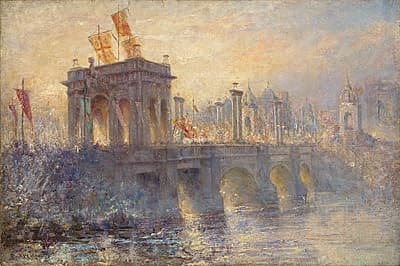Frederick
MCCUBBIN
Australia
1855
–
1917
Arrival of the Duke and Duchess of York, Melbourne, 1901
c.1908
oil on paper on canvas
signed 'F McCubbin' lower left
59.4 (h)
x 89.8 (w)
cm
National Gallery of Victoria, Melbourne
purchased with the assistance of a special grant from the Government of Victoria, 1979
Arrival of the Duke and Duchess of York, Melbourne, 1901 presents the royal party’s procession across Princes Bridge during the federation celebrations of 1901. They followed a route from St Kilda pier, across the city to the Melbourne Exhibition Building, where the Duke inaugurated the first Australian Federal Parliament on Friday 9 May. The couple’s reception was warm and enthusiastic wherever they went in Australia. The streets were heavily decorated with flags and buntings and at major intersections huge, elaborate arches were constructed.
McCubbin based this work on the small study of the same subject he had made some seven years earlier, at the actual time of the event, Triumphal arch at Princes Bridge, Melbourne (cat 1), but in this later version McCubbin adopted Turneresque high-key colours of blues, pinks and whites, rather than the darker gold-pink-purple palette of the earlier picture.
Turner’s influence is evident in the palette, in the rendering of radiant light and in the experimental handling of paint. McCubbin modified the surface of the canvas to make it more absorbent and give it more tooth, applying his paint in layers, dry on dry, to create a thick impasto, with flicks of paint on the surface. There is an almost abstract use of paint where the paint has been applied so that it is hard to see the actual brushstrokes. This adventurous approach demonstrates McCubbin’s new confidence in handling his materials.
The rich brilliance of McCubbin’s paint, and the pomp of his image of the long arched bridge, recalls in particular Turner’s Ancient Rome: Agrippina landing with the ashes of Germanicus. The triumphal bridge and palace of the Caesars restored c 1839 (Turner Bequest, Tate) and Burning of the Houses of Lords and Commons c 1835 (Philadelphia). Following the example of Turner, McCubbin synthesised the effects of light, air and water. His triumphal bridge, however, heralds in the new era of the federated states, unlike Turner’s images which point to the decline of the Roman empire or destructive fire.
McCubbin depicted the scene looking towards the city’s north west, from the south bank of the Yarra River, east of Princes Bridge. It was a more distant viewpoint than in the earlier sketch (cat 1) and allowed him to capture the glistening water in the foreground, the expanse of the bridge with its triumphal arches, columns and minarets, and the many flapping banners. But more importantly, the whole structure seems suffused with light.
When exhibited in 1908, one reviewer commented prosaically that ‘Another important work is The Arrival of the Duke and Duchess of York, 8th May, 1901. They are depicted making their entrance at the triumphal arch at Prince’s Bridge—the gateway of the city’ (Herald, Melbourne, 14 May 1908, p 4).
McCubbin’s view differs from contemporary photographs of the scene, which show it from up high, along the bridge, directly through the temporary arch, with flags flapping above and beside. From this vantage point it is possible to see the parade and the crowd gathered to view it—but there is not the radiant majesty of McCubbin’s painting. McCubbin not only depicted the scene, but captured the fervor and popular passion of the event.
While focussing on the visual excitement of the scene, McCubbin also gave his picture a serious narrative: the inauguration of Parliament in the Melbourne Exhibition Building was an historic occasion highlighted by the final words of the Duke’s speech: ‘Gentlemen of the Senate and Gentlemen of the House of Representatives, it affords me much pleasure to convey to you this message from His Majesty. I now, in his name and on his behalf, declare Parliament open’ (Age, 10 May, 1901).
The Royal tour, which took in all Australian states, was a great success, with an estimated 100,000 attending the royal landing in the Domain in Sydney. McCubbin successfully expressed the atmosphere of the pomp and glory of the occasion, and the importance of the moment in Australia’s history.
,
